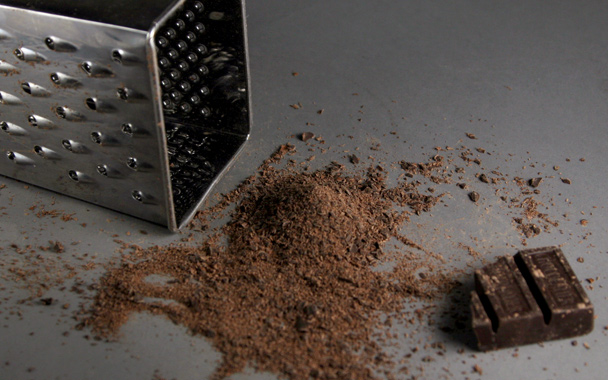Ask most people what they prefer in a dessert, or any sweet snack, and more often than not the answer will be chocolate. Indeed, at Le Bernardin, our chocolate offerings sell twice as well all of the other options combined. But why limit this dark, complex ingredient to just one section of the menu? A look at culinary history reveals that chocolate has long been used in savory dishes as well, and recent research on taste offers some good reasons to bring back the tradition.
As many chocolate lovers know, the ingredient originated in Central America during the Mayan empire, more than 2,000 years ago (or possibly even earlier). In a process that has remained virtually unchanged since, cacao pods were harvested and split; the “beans” (technically seeds) inside were fermented and dried, then roasted, ground to a paste, and mixed with water and spices to produce a thick, foamy, bitter beverage. For almost two millennia, chocolate was used primarily in this drink (which bore very little resemblance to modern hot cocoa); research indicates that chocolate may also have been incorporated into a porridge-like corn mash, the cacao adding a foamy, bitter note to the sweetness of the corn. (Today, I could easily see a little dark chocolate making a great addition to Italian-style polenta). The most popular savory use of chocolate today is mole, which didn’t actually appear until the 16th or 17th century. The original version of this complex dish (which can have a dozen or more ingredients, including chocolate, onion, garlic, chile peppers, and various spices) was believed to include turkey, although today it’s commonly made with chicken. And in some parts of Central America, cacao was simply ground along with chiles and spices and rolled into balls, to be grated over a variety of dishes.
It was only after chocolate was imported to Europe in the 1500s that it was first combined with sugar, but that doesn’t mean that European chefs didn’t use it in savory dishes as well. As chocolate migrated from the Iberian Peninsula into Italy and France, it was most often served with game and in braised dishes: hare, venison, and duck. Indeed, adding small amounts of bittersweet chocolate or cocoa powder to such stews, either at the beginning of the cooking process or at the end, lends complexity and color. Another early European use for chocolate was in agrodolce (literally “sour and sweet”), an Italian sauce made from reduced wine or vinegar. And to this day, some recipes for coq au vin include an underlying note of chocolate (although the practice has remained somewhat limited to Spain and Italy). In the version served at Napa Valley’s Bistro Jeanty, a pinch of cocoa stirred in at the end adds an element of sophistication.
Contemporary cooks can beef up their wine reductions and pan sauces with a hit of grated chocolate, where it acts as a liaison or emulsifier, at the same time accentuating other flavors and pulling them forward. A simple chocolate-laced reduction of Port and Sherry vinegar marries well with fowl or meaty fish, such as monkfish. The key is to use a small amount of quality chocolate that isn’t too sweet—look for cacao content of 70 percent or higher.
As it happens, plenty of savory winter ingredients have an affinity for chocolate. Alice Medrich, in her book Bittersweet (Artisan, 2003), includes more than a few such recipes: cacao nibs infused into cream enriches a squash soup; a sweet and smoky wild mushroom ragout benefits from a small chunk of unsweetened chocolate; and a meat sauce for pasta gets its complexity from agrodolce made with chocolate (and if you really want to take it over the top, try adding a little cocoa powder to your fresh pasta dough as well). Years ago, I was treated to an amazing dish at Clio in Boston, where chef Ken Oringer married cocoa with sweet parsnip purée and earthy black truffle. In New York, chef Sam Mason of Tailor (who started out as a pastry chef) served blocks of foie gras sprayed with a velvety chocolate coating. And a few chefs have taken the idea even further, constructing entire tasting menus with chocolate. Frederic Bau, Valrhona’s corporate pastry chef, wrote the book on it; his Fusion Chocolate (Montagud, 2006) explores the varied possibilities of chocolate through inventive appetizers, soups, main courses, and, yes, even desserts.
If all those examples haven’t yet piqued your curiosity, perhaps science will win you over: In recent years, flavor-chemistry research has indicated that foods with similar protein molecules should, in theory, go well together. More than a few chefs have been paying close attention, most famously Heston Blumenthal, of the venerable Fat Duck in England. He hit upon the combination of white chocolate and caviar, at first thinking that the pairing worked so well because of the saltiness of the caviar (indeed, salt enhances the flavor of chocolate, even in sweet preparations). Later, a chemist confirmed that both ingredients contain the protein trimethylamine. Many other odd-sounding combinations share their own chemical commonalities: Roasted cauliflower and cocoa are one surprisingly good couple; and while chocolate and garlic don’t exactly sound like a match made in heaven, invite their mutual friend, coffee, and it’s a party (at least under a microscope). And I’ve gotten into the game myself: On a recent all-chocolate showdown of Iron Chef America, our team incorporated chocolate into a geoduck ceviche. While on paper that may sound challenging, the bitter flavor, texture, and fattiness of the chocolate all elevated the cool complexity of the dish. That successful experiment left me convinced that no matter what your mother may have told you, it’s perfectly acceptable to eat chocolate for dinner.




 Pinterest
Pinterest


